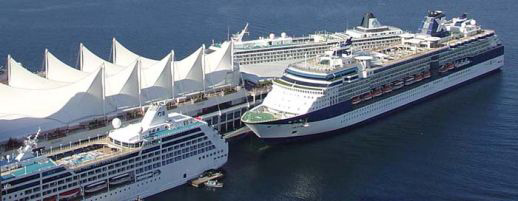
Alaska-bound cruise ships in dock, at Vancouver’s harbourfront Canada Place terminal
What images spring to mind when you imagine a northern cruise vacation? Crystal clear water, teaming with sea life; humpback whales frolicking for your viewing pleasure; or perhaps just the vastness of British Columbia’s pristine coast, and a wild azure blue ocean untouched by human pollution.
These images contradict the current reality of the cruise industry.
A single cruise ship discharges approximately 1.3 million litres of waste water per day, more than the port city of Haines, Alaska.
In an article published in The Dominion, writers Yuill Herbert and Karen Gorecki report that:
- The American environmental group, the Blue Water Network, estimates that 77% of all ship waste comes from cruise ships
- Two billion pounds of trash is dumped into the world’s oceans each year and 24% of that waste comes from cruise ships
- 14 million kilograms of waste was produced in 2000 on the Alaska-Canada route alone
- Cruise ships have accrued over $60 million in environmental fines over the last five years in the U.S. Yet, in Canada, due to a lack of monitoring and enforcement there have been no fines, despite the fact that these same ships visit our waters
- Greenhouse gas emissions of international ships are excluded from the national emissions inventories, a loophole in the Kyoto Accord which benefits cruise ship lines
The Vancouver Island Public Interest Research Group’s report, Ripple Effects: The Need to Assess the Impacts of Cruise Ships in Victoria B.C. not only serves to reinforce the points made by Herbert and Gorecki, among other findings the report’s authors learned that cruise “ships burn fuel that has sulphur content 90% higher than that used by cars.”